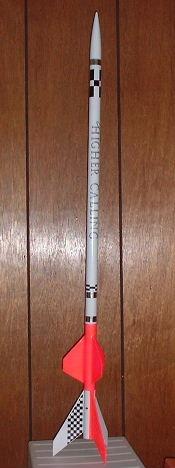Scratch Higher Calling Original Design / Scratch Built
Scratch - Higher Calling {Scratch}
Contributed by Ted Phipps
| Manufacturer: | Scratch |
 Brief:
Brief:
The idea for this rocket was to create a minimum diameter gap-stager designed
for speed and altitude, while still flying on economical Estes D12-0 and D12-7
motors.
Parts
Sustainer- 1 Estes PNC-50 nosecone
- 28" BT-50 or equivalent (mine came from Totally Tubular, if you use Estes tube, you'll need to add a coupler for the extra length.)
- 2"-3" length of BT-50 for inner reinforcement
- 24mm engine block
- 1/8" balsa for fins
- shock cord, I used 12' of 1/4" elastic attached with the Estes 'paper sandwich' method
- 3/16" launch lug or rail button
- 4" BT-50 or equivalent
- 24mm engine block
- 1/8" balsa for fins
- 3/16" launch lug or rail button
Construction
All glue joints are done with yellow wood glue. All body tube grooves were filled with Elmer's Fill 'n' Finish, and then sanded smooth. Fin fillets were done with yellow glue, then another coat with Fill 'n' Finish sanded smooth, and then finally painted with thin CA for extra strength.
See the attached RocSim file for fin templates. (above right)
Sustainer Construction
Take the 2"-3" length of BT-50 and slit it lengthwise, then remove a small sliver. The idea here is to create an elongated tube that will slip inside the main body tube. Glue this reinforcement inside the main body tube, positioning it near the top of the sustainer fins and making sure it doesn't interfere with the placement of the thrust ring. The reason for this extra tube is that the area just ahead of the fins is where a rocket will often crumple - either under thrust or on landing. I had to do this after the first flight, it'll be easier to do during construction instead of as a retrofit.
Position the engine block so that the inserted D12 motor extends out the back between 1/4"-1/2".
The rest of the sustainer is simple Estes-style construction. For extra strength, you can coat the inside of the body tube with thin CA.
Booster Construction
The fins are attached even with the front of the body tube. This allows about a half inch of body tube at the motor end to accept a wrap of masking tape for motor retention.
Position the engine block so that the inserted D12-0 extends out the back about ¼". Just above the booster engine block, cut three holes in the body tube - between the fins - to vent the ejection gasses that might separate the booster before igniting the upper stage motor. You can use a hole punch to make these holes, or carefully cut them with a hobby knife. Soak thin CA into the area around the holes for strength. You can see one of the vent holes in the picture.
Painting and Finishing
The entire rocket was primered and painted gloss white. Once that was dry, the fin can of the sustainer was masked off and painted with fluorescent pink, as was one fin of the booster.
Final details were added using chrome mylar tape for striping, and then the name and checkerboard patterns were created with a laser printer using MS PowerPoint and Papa Tango decal paper.
Empty weight for the booster was .75 ounce (21.5 grams), and the sustainer was 1.5 ounces (43 grams). These seem unusually light to me, and the only explanation I can think of is that the body tubing I used is from Totally Tubular, and doesn't appear to be as heavy (nor as strong) as standard Estes tubes. The rocket was weighed on a recently-calibrated postal scale, so I'm confident that the weights as stated were correct.
Flight Prep
Friction fit a D12-7 into the sustainer and a D12-0 into the booster. Fit the stages together, using the upper stage motor as the coupler. It's important that the fit between stages be smooth and not too tight. A little light sandpaper used around the nozzle end of the D12-7 might be needed.
Add wadding of your choice, then the recovery device. Because of the tight space and expected altitude, we use two pieces of fluorescent flagging tape as streamers, each 1" wide by at least 6 feet long. Packing the streamers can be a challenge, especially if the wind is acting up.
Flight History
The first flight was on BattlePark '02 in Culpeper, Virginia. The boost was great and she staged perfectly (really high too), but just after separation the sustainer body tube let go a little bit and she wobbled to apogee. It looked like the kick of the D12-7 igniting was just too much for a weak spot in the body tube and it crimped, turning the sustainer into a banana. I cut the body apart at the crimp and installed a coupler as reinforcement so she could fly again.
She made three more beautiful single-stage flights, all on D12-7's before being lost. Estimated altitude for these flights was around 1500 feet.
Summary
This is a fun and simple rocket to build and fly, and she's definitely light enough to fly C6's with adapters. You can also adjust the position of the sustainer thrust ring and use an E9 in the upper stage for even more altitude. Gap staging eliminates many of the hassles of multi-stage prep.
 |
 |